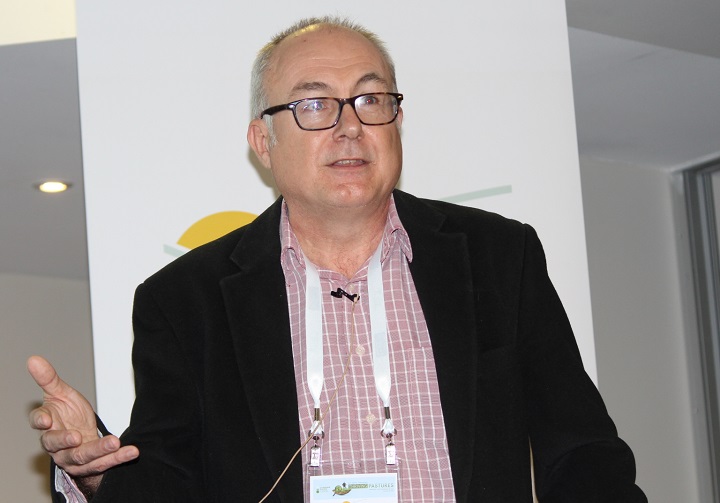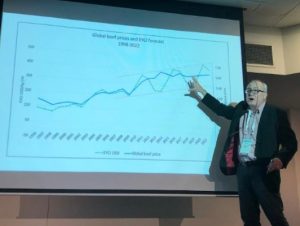
Simon Quilty at the GSSA conference in Victoria this week.
LAMB price and flock dynamics are adding urgency to sheep producers’ restocking decisions, according to international meat broker and analyst Simon Quilty.
Mr Quilty told delegates at the 60th annual Grassland Society of Southern Australia conference at Creswick this week that Australian lamb and beef prices were entering “a new domain” and producers need to think “long and hard” about buying in.
“If you have liquidated your breeders, now is the time to step in on cattle.
“On sheep, you’ve had the luxury of two or three very good years, and that is going to continue next year, but after that you’ve got to double-think about whether you start to restock, because you are going to end up with some expensive animals which in a falling market isn’t that good.”
This could mean ewe producers or lamb traders with mixed sex maternal lamb lines holding back some ewe lambs as breeder. Some lot feeders and traders have this year been making up heavy old lamb consignments with first cross ewe lambs as rates pushed above $250 in saleyards, meaning fewer will be available as 1.5 year-olds in coming breeder sales.
“I think like anything, it (lamb) is a commodity, and what you notice when you have high commodity prices like this, unfortunately niche marketing flies out the window.
“The premium for organic in cattle disappears, because if it goes to 850 cents and you need another 40 cents to justify organic, forget it, the market is not going to pay you that.”
He said his forecasts show that lamb prices will peak next year and then a year later prices will be similar to this year and then lower again by 2022 as supply increases.
“So it comes down to can you make a dollar out of what effectively is, after next year, a falling market.”
Mr Quilty said if producers had not restocked with ewes by next year they might have “missed the boat”.
“If you restock now you will get some of the upside here, but I would be advising to be careful after mid next year about going out and restocking, because the market will peak next year.
“It may not necessarily collapse, but it needs to find another trading level at which you can trade in and out with confidence,’ he said.
“And I don’t know where that is going to be — all I know is that the following year it is going to be lower and the year after that it is going to be slightly lower.”
Mr Quilty said the same restocking issues would face cattle breeders, although he expected the peak in cattle prices to come around September 2021.
“The same issues will apply, that people don’t want to get stuck at the top of the market with cattle or with sheep, because it can get ugly, particularly if we tip into another drought.”
Lamb and beef prices expected to rise

Meat trader Simon Quilty explains the relationship between beef and lamb prices
Mr Quilty told the GSAA conference he believed beef and sheep meat prices would continue to rise after predicted drought-breaking rains this year, underpinned by a continuing global protein shortage, high world meat prices, limited global herd growth, and Australia’s low beef herd and sheep flock.
Mr Quilty said only a global recession could drive the current Eastern Young Cattle Indicator lower than its current level, but later added that a continuing US-China trade war could lead to just that.
He said Mr Trump’s whole approach on increasing tariffs on Chinese imports was flawed and represented a global recession risk.
“To date, since he started introducing tariffs on Chinese, which were $250 billion worth if you remember, he’s collected $20.6 billion and he’s paid out to farmers $28 billion – they are $8 billion behind already.”
“The second point is, it hasn’t worked, it has gone to Vietnam, the cheaper production, that is tariff free going into the US, and it goes on and on with other cheaper economies and labour around the world.
“So it is flawed kind of system and I think reality is hitting home because the US economy could falter,” he said.
“The best thing we can say is that if he keeps this up, he will drag the world into recession.”
Mr Quilty believes “commonsense will prevail,” but he said the Chinese have already introduced a rule preventing US pork imports.
“That problem (African Swine Flu) is growing by the day and by the end of the year, half their pork will be gone.”
EYCI to go to 850 cents, heavy lambs to 1050c/kg
Mr Quilty believes Australian lamb and beef prices will continue to rise after drought-breaking rains this year, and sounded a warning to the delegates to consider whether they could restock if stock prices increased dramatically.
He predicted that the Eastern Young Cattle Indicator would reach 850 cents between July and September in 2021 and that good prices would continue into 2022.
“Effectively we’ve got 5-10 years of strong global prices.”
He predicted Victorian heavy lamb prices would reach 1050c/kg cwt in August next year, arguing that prices at this level were sustainable, because domestic demand only took 20-30pc of supply and export demand drives the market.
But Mr Quilty predicted the higher livestock prices would hurt Australian processors, with rationalisation potentially occurring among domestic operators rather than exporters.
“We will have closures, but that’s part of the meat industry in Australia.
“It is going to be substantial.”
Mr Quilty’s forecasts considered expected global meat prices, the impact of the African Swine Fever outbreak in China on global protein demand, the growing Asian middle class, previous post-drought rainfall and price trends in Australia, and the current low Australian herd and flock numbers.\
Mr Quilty said the ASF outbreak has already been a factor in China’s increasing lamb, mutton and beef imports. He expected the outbreak’s impact on the mutton market could last about five years.
“But the peak in mutton (price) will be next year as well.”
China’s pork population of 430 million head comprised half the world’s pigs, representing 20pc of total global protein, he said, but by the end of this year ASW will eliminate half of these, removing 10pc of the world protein supply.
“And they (the Chinese) are buying at a rate of knots, our meat; they can’t get it quick enough.
“So there will be shortages that will drive global, pork, poultry, beef markets higher,” Mr Quilty said.
“China is going to drive all prices higher.”
Beef and lamb markets are linked
Mr Quilty expected the growth in beef and lamb prices over the past 3-4 years to continue into 2022 because of the global protein shortage, and said the two markets were linked, with Australia’s flock and beef herd moving in tandem since 2010.
“An oversupply of lambs will see lamb prices fall and an undersupply of lambs will see lamb prices go above beef prices.
“It trades around the value of global beef,” he said.
“Sheep meat makes up only 15 million tonnes a year of our global supply, beef is 70 million (tonnes).”
Mr Quilty is expecting a dip in Australia’s lamb slaughter next year and this would start to rebuild as the flock increased.
“And with that, the peak will occur next year in lamb prices, in 2020.”
He believed Australia’s flock would be below 60 million next year and without many lambs coming forward, prices will be high and would reflect global beef prices.
Meat prices in a new domain
Mr Quilty illustrated how the Eastern Young Cattle Indicator is linked to US cattle prices, and how cattle prices always rebounded after a drop in Australia’s beef herd and drought-breaking rain.
He said during Australia’s three previous droughts the EYCI averaged 294 cents in 2002-2003, 2006-2009 326 cents, 325 cents in 2013-2014 and the average low since the start of 2018 till today is 500 cents.
“So we have gone to another level in terms of the value of cattle in Australia.
“This is the lowest it will ever go, the only thing that will push this lower is a global recession,” he said.
“So I think we are now in a new domain in terms of global meat prices and cattle prices,” he said.
With the EYCI currently at 518 cents, and taking into account its close relationship to US cattle prices, previous price rises after drought and the decimated Australian female cattle herd, Mr Quilty predicted that the indicator would average 500 cents this year, rising to a mean of 607 cents in 2020 and to 750 cents in 2021 before falling to 693 cents in 2022.
Mr Quilty expected the current cattle price cycle to last about 230 weeks.
“It will be longer than the other previous cycles and that’s because of the liquidation of the herd today.
“It’s far far greater than any other liquidation we’ve had in recent history,” he said.
“We are going to end up with a herd next year of around 24.5 million; that’s a very low herd, a 30-year low.”
Mr Quilty expected the herd to take longer to rebuild than before, but the rebound in pricing because of the “deep low” is going to happen quicker.
“The market is going to react quickly and we are seven weeks now into this cycle.
“So hold on because it is going to go fast and furious as we head towards 850.”
Beef trader cum weather forecaster
Another key factor in future beef prices would be the depleted sheep flock and the impact of drought-breaking rain, Mr Quilty said.
Considering recent rainfall across Australia and comparing long-term rainfall trends in the two years after extremely dry drought years similar to 2018, he has gone against Bureau of Meteorology forecast for a dry late 2019 to predict drought-breaking rain in Queensland starting in October-November.
“And I’m backing myself before BOM.”
He conceded he was not a weather expert, but a believer in history repeating itself, and his analysis implied a continued wet winter for Victoria.
“The wild card here is New South Wales; that’s the state that’s struggling the most and found it most difficult.
“But I would like to think that once again we start to see some benefits of a wet season in the north starting to come down into New South Wales.”
Mr Quilty said the female cattle kill (as a percentage of the total cattle kill) might have peaked at 55pc in Australia’s three previous droughts 2002-3, 14/15, 2009-10, but the current figure of 58pc — beef and dairy cows — meant recovery would take longer.
“So we’ve bitten hard and the harder you fall the bigger the rebound, because there is simply less females to buy out there to restock to get your place going again.”
Mr Quilty said he expected there would be some very conservative views about the weather and markets.
“And mainly because no-one wants to have their reputation slandered basically because they got it wrong.
“But to me this is all about trying to understand what’s driving the market and the fact that if in six months’ time when you finally agree the drought’s broken and cattle prices are up another 50 percent and you missed the train and you can’t restock, then what’s the point I say, let’s talk about it now.
“Is it affordable to restock, do you have the grass to do so?”
“I’m telling you at some point here, it could become very cost prohibitive.”

HAVE YOUR SAY